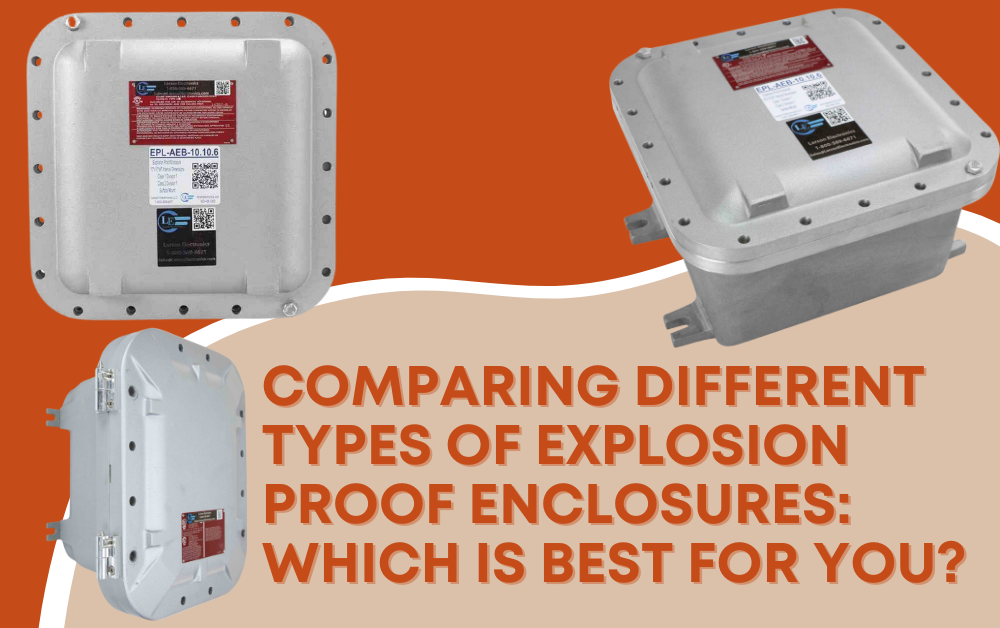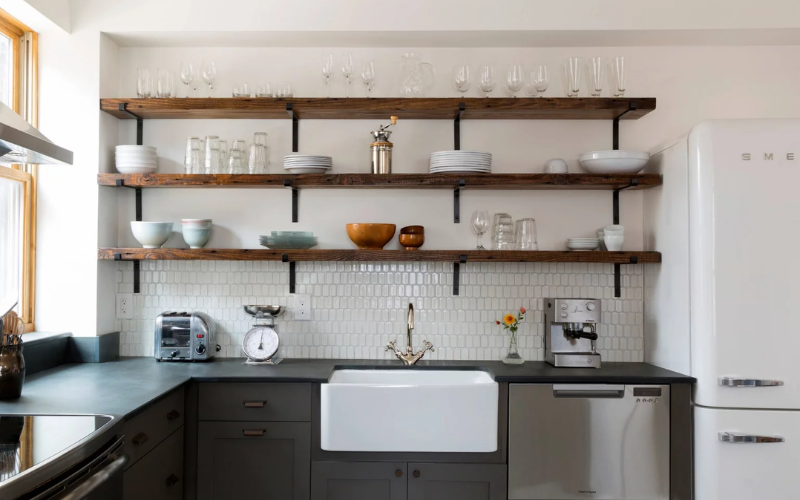Introduction
In the world of industrial safety, one cannot overemphasize the significance of explosion proof enclosure. These specialized protective units play a pivotal role in averting catastrophic incidents in environments where the slightest spark could lead to disaster. In this extensive guide, we will simplify the complexities of explosion-proof enclosures and delve into the nuances of different types. Whether you’re a seasoned professional or a newcomer to the field, this comprehensive resource will help you navigate the terrain of explosion-proof enclosures with ease.
Understanding the Essence of Explosion-Proof Enclosures
Before we embark on a journey to compare different types of explosion-proof enclosures, let’s lay a solid foundation by understanding what these enclosures are and why they are an absolute necessity.
Demystifying Explosion-Proof Enclosures
At its core, an explosion-proof enclosure, commonly referred to as an Ex enclosure, is a formidable housing designed to withstand internal explosions without allowing them to propagate and ignite the surrounding atmosphere. These enclosures are meticulously crafted with specialized materials and construction techniques to ensure that they can effectively contain the consequences of an explosion.
A Dive into the World of Diverse Types
Not all explosion-proof enclosures are created equal; each type has its own unique characteristics and applications. Let’s embark on a journey to explore the most prevalent types of explosion-proof enclosures.
1. Flameproof (Ex d) Enclosures
Ideal Environment: Areas with flammable gases or vapors.
Flameproof enclosures are engineered to endure internal explosions while effectively restraining the flames from igniting the adjacent atmosphere. They find their true calling in environments where the potential for explosions due to gases or vapors is high.
2. Increased Safety (Ex e) Enclosures
Ideal Environment: Areas prone to combustible dust.
Increased safety enclosures are all about minimizing the risk of sparking, arcing, or heating that could set off flammable substances. They are commonly deployed in areas where combustible dust presents a potential hazard.
3. Intrinsic Safety (Ex i) Enclosures
Ideal Environment: Areas with explosive gases or vapors.
Intrinsic safety enclosures take a different approach by curtailing electrical energy to non-incendiary levels. By doing so, they substantially reduce the risk of sparking and ignition in areas that house explosive gases or vapors.
4. Pressurized (Ex p) Enclosures
Ideal Environment: Environments requiring pristine internal atmospheres.
Pressurized enclosures uphold a higher internal pressure compared to the surrounding atmosphere. This intelligent design prevents flammable gases or dust from infiltrating the enclosure, making them a perfect choice for settings where maintaining a clean internal atmosphere is paramount.
5. Dust-Ignition Proof (Ex t) Enclosures
Ideal Environment: Industries like food processing.
Dust-ignition proof enclosures are meticulously designed to thwart the ignition of combustible dust. They are primarily found in industries where fine dust particles pose a substantial risk, such as food processing.
Critical Factors in the Decision-Making Process
Selecting the most suitable type of explosion-proof enclosure hinges on a profound understanding of your specific requirements and the characteristics of the environment it will inhabit. Here are pivotal factors to consider when making this crucial decision:
1. Hazardous Area Classification
Before you zero in on an enclosure type, it is imperative to decipher the classification of the hazardous area. Different areas may necessitate distinct types of enclosures based on the types of hazardous substances present.
2. Environmental Conditions
The environmental conditions within your facility are also paramount. Take into account variables such as temperature, humidity, and exposure to corrosive substances. Ensure that the chosen enclosure can withstand these conditions effectively.
3. Material Compatibility
Pay meticulous attention to the compatibility of the materials used in the construction of the enclosure with the hazardous substances present in the environment. Material compatibility is crucial for long-term effectiveness and safety.
4. Size and Capacity
Determine the requisite size and capacity of the enclosure based on the equipment or processes it will encase. It is imperative to ensure that the chosen enclosure offers sufficient space without compromising safety.
5. Certification and Compliance
Look for enclosures that have earned international certifications and comply with industry standards. Certifications such as ATEX in Europe or NEC/CEC in North America serve as testaments to the enclosure’s adherence to safety requirements.
6. Maintenance Requirements
Consider the maintenance needs associated with the chosen enclosure. Some enclosures may necessitate more frequent inspections and maintenance compared to others. It is crucial to factor this into your decision-making process to ensure seamless operations.
7. Cost
While safety is unequivocally paramount, it is equally important to take the budget into consideration. Balancing safety requisites with cost-effectiveness is essential to make a pragmatic choice that aligns with your financial constraints.
Also read – Importance of Compliance: learn explosion-proof enclosures
A Comprehensive Comparison of Types
Now that we’ve laid the groundwork and explored the different types of explosion-proof enclosures, let’s dive into an in-depth comparison:
Flameproof (Ex d) vs. Increased Safety (Ex e)
- Flameproof (Ex d): These enclosures are designed to withstand internal explosions and effectively contain flames. They are ideally suited for areas with flammable gases or vapors.
- Increased Safety (Ex e): These enclosures prioritize minimizing the risk of sparking, arcing, or heating. They are perfect for areas where combustible dust poses a potential threat.
Intrinsic Safety (Ex i) vs. Pressurized (Ex p)
- Intrinsic Safety (Ex i): These enclosures are engineered to limit electrical energy to non-incendiary levels, effectively reducing the risk of sparking and ignition. They find their niche in areas housing explosive gases or vapors.
- Pressurized (Ex p): These enclosures maintain a higher internal pressure compared to the surrounding atmosphere, effectively preventing the ingress of flammable gases or dust. They are ideal for environments where the preservation of a clean and safe internal atmosphere is paramount.
Increased Safety (Ex e) vs. Dust-Ignition Proof (Ex t)
- Increased Safety (Ex e): These enclosures are tailored to minimize the risk of sparking, arcing, or heating. They are well-suited for environments where combustible dust is a prevailing concern.
- Dust-Ignition Proof (Ex t): These enclosures are designed to thwart the ignition of combustible dust and are commonly found in industries where fine dust particles can pose a significant risk, such as food processing.
A Comprehensive Look at Flameproof (Ex d) Enclosures
Flameproof enclosures, categorized as Ex d enclosures, are widely employed in industries where the presence of flammable gases or vapors is a constant threat. Let’s take an in-depth look at their features and advantages:
Features:
- Robust Construction: Flameproof enclosures are engineered with robust construction to withstand internal explosions effectively.
- Flame Containment: Their design is meticulously tailored to contain the flames generated during an explosion, preventing them from igniting the surrounding atmosphere.
- Versatility: Flameproof enclosures are versatile and find application in various industries, including petrochemical, oil and gas, and chemical manufacturing.
Advantages:
- Exceptional Safety: Flameproof enclosures are highly effective in containing explosions, thereby protecting both personnel and equipment.
- Versatility: They are versatile and adaptable, making them suitable for deployment in diverse industries.
A Comprehensive Look at Increased Safety (Ex e) Enclosures
Increased safety enclosures, classified as Ex e enclosures, are designed to minimize the risk of sparking, arcing, or heating that could trigger the ignition of flammable substances. They are commonly utilized in environments where combustible dust is a prevalent hazard. Let’s delve into their features and advantages:
Features:
- Risk Mitigation: Increased safety enclosures are engineered to reduce the risk of sparking, arcing, or heating that could lead to explosions.
- Ideal for Dust: They are particularly suitable for industries where combustible dust is a significant concern, such as woodworking, agriculture, and food processing.
Advantages:
- Dust Protection: Increased safety enclosures effectively mitigate the risk of electrical faults causing explosions in areas with combustible dust.
- Wide Applicability: They are versatile and cater to industries where dust is a predominant concern.
A Comprehensive Look at Intrinsic Safety (Ex i) Enclosures
Intrinsic safety enclosures, categorized as Ex i enclosures, are specifically designed to limit electrical energy to non-incendiary levels. This strategic design significantly reduces the risk of sparking and ignition, making them suitable for use in hazardous areas with explosive gases or vapors. Let’s explore their features and advantages:
Features:
- Energy Limitation: Intrinsic safety enclosures are meticulously engineered to limit electrical energy to levels that do not pose an ignition risk.
- Suitable for Explosive Gases: They are particularly apt for use in industries where explosive gases are present, such as mining and chemical manufacturing.
Advantages:
- Heightened Safety: Intrinsic safety enclosures offer a high level of safety by minimizing the risk of electrical ignition.
- Wide Applicability: They find utility in industries where explosive gases are a constant presence.
A Comprehensive Look at Pressurized (Ex p) Enclosures
Pressurized enclosures, classified as Ex p enclosures, maintain a higher internal pressure compared to the surrounding atmosphere. This intelligent design effectively prevents the infiltration of flammable gases or dust. They are ideal for environments where maintaining a clean internal atmosphere is paramount. Let’s explore their features and advantages:
Features:
- Positive Internal Pressure: Pressurized enclosures uphold a positive internal pressure, creating a barrier that prevents hazardous substances from entering.
- Clean Atmosphere: They are tailored for environments where the preservation of a clean and safe internal atmosphere is essential.
Advantages:
- Environmental Control: Pressurized enclosures ensure a clean and safe internal atmosphere, making them ideal for industries like pharmaceuticals, semiconductor manufacturing, and laboratories.
- Hazard Prevention: They effectively thwart the entry of hazardous substances, adding an extra layer of protection.
A Comprehensive Look at Dust-Ignition Proof (Ex t) Enclosures
Dust-ignition proof enclosures, categorized as Ex t enclosures, are explicitly designed to prevent the ignition of combustible dust. They find application in industries where fine dust particles can pose a significant risk, such as food processing. Let’s examine their features and advantages:
Features:
- Dust Ignition Prevention: Dust-ignition proof enclosures are engineered to eliminate the possibility of ignition when combustible dust is present.
- Spark Containment: Their design effectively contains dust particles and prevents sparking.
Advantages:
- Safety Assurance: They guarantee safety in environments where combustible dust is a potential hazard.
- Industry Relevance: Dust-ignition proof enclosures are particularly relevant in industries like food and beverage, grain handling, and pharmaceuticals.
The Art of Making an Informed Choice
Selecting the most appropriate type of explosion-proof enclosure is contingent on a meticulous assessment of your specific requirements and the environmental conditions within your facility. Here are some critical steps to guide you towards making an informed choice:
1. Conduct a Hazardous Area Classification
Commence the journey by conducting a thorough assessment of the hazardous areas within your facility. Identify the zones where explosive gases, vapors, or dust may be present. This classification is pivotal in determining the level of protection required for the explosion-proof enclosure.
2. Choose the Right Enclosure Type
Select an explosion-proof enclosure that is not only certified but also tailored for the specific hazardous area classification. Ensure that the chosen enclosure aligns with the requirements stipulated in relevant regulations, such as ATEX, NEC, CEC, or IECEx.
3. Professional Installation
Always opt for the installation of explosion-proof enclosures by certified professionals who possess comprehensive knowledge of the regulations and standards. Proper installation is critical to ensuring the functionality and safety of the enclosure.
4. Implement Routine Inspections and Maintenance
Establish a routine inspection and maintenance schedule for all explosion-proof enclosures within your facility. Regular checks are essential to ensure that the enclosures remain compliant and function optimally.
Inspections should encompass visual assessments, functional tests, and verification of seals and gaskets. Any identified issues or wear should be promptly addressed through maintenance or replacement.
Staying Ahead of Regulatory Changes
The landscape of explosion-proof enclosure regulations is dynamic, subject to constant updates and revisions. To maintain compliance and ensure that your safety measures remain current, it is essential to stay informed about any changes in the regulatory arena. Here are some strategies to keep you on the right track:
1. Regularly Monitor Regulatory Updates
Stay attuned to regulatory changes by subscribing to updates from relevant regulatory authorities or industry associations. This proactive approach guarantees that you are well-informed about any new requirements or standards that may impact your operations.
Regulatory bodies are known to release updates and amendments to existing regulations. Staying informed about these changes is pivotal to adapting your safety practices and equipment to remain compliant.
2. Engage with Industry Experts
Establish a rapport with industry experts, consultants, or safety professionals who specialize in explosion-proof equipment. Their wealth of expertise can provide invaluable insights and guidance on compliance.
Industry experts are well-versed in the latest regulations and can offer tailored advice pertinent to your specific applications. Their knowledge serves as a beacon to help you navigate the intricate
Conclusion
In the realm of industrial safety, few considerations are as crucial as the choice of explosion-proof enclosures. These specialized housings play a pivotal role in preventing catastrophic explosions caused by the ignition of flammable substances in hazardous environments. As we conclude our exploration of different types of explosion-proof enclosures, it becomes evident that the journey to safety is paved with knowledge, understanding, and informed decision-making.



